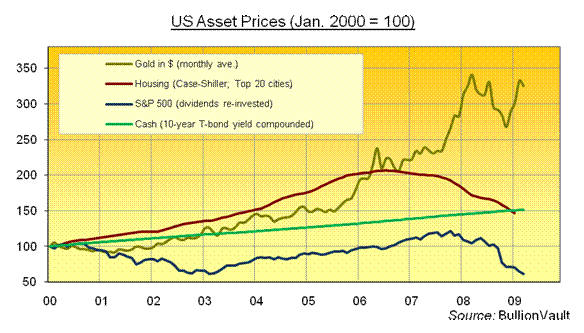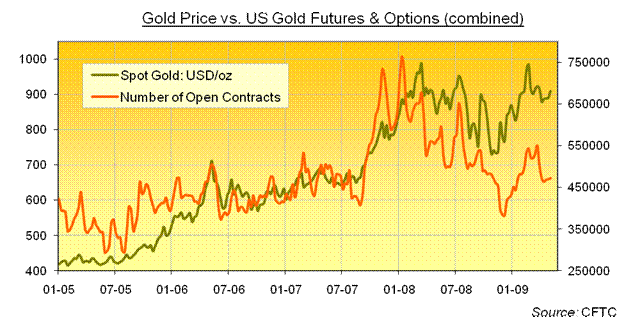Gold 2009: Trend, Forecasts and the Story So Far
Commodities / Gold & Silver 2009 May 15, 2009 - 02:24 PM GMTBy: Adrian_Ash
 Whether inflation or deflation strikes, a growing number of people are fast buying gold for defence...
Whether inflation or deflation strikes, a growing number of people are fast buying gold for defence...
IT'S COMMON KNOWLEDGE that gold bullion proved the most reliable wealth-store during the vicious inflation of the late 1970s. Yet almost un-noticed, gold has once again been the best-performing asset bar none this decade, too.
Gold has dominated the 21st century so far, in fact – something which will look plain to future investors, although only a handful appreciate it today.
Whether gold can now extend or repeat this performance, of course, is less clear. But "People rightly buy gold when they fear inflation ahead," as William Rees-Mogg, a keen historian of gold, puts it. And just as during the Great Depression of the 1930s, many people now fear inflation, sparked by the very threat of deflation driving government interventions and central-bank money creation.
That's why global demand for gold jumped throughout 2008, rising 26% on the GFMS consultancy's data, just as the US, British and Swiss central banks moved to begin quantitative easing – a.k.a. printing money.

Gold Prices had already trebled and more against the world's major currencies, gaining an average 14% per annum in Sterling terms since the start of 2000.
Yet gold still remains a "fringe" asset class for most funds and advisors. High-margin offers and outright scams are starting to trap the unwary, while good information about how to buy, own and trade the metal remains scarce. Quite how much of your wealth you allocate to this "ultimate insurance" is something to decide for yourself. But buying and selling gold can now be much simpler and safer than during gold's last multi-year run. It should be dramatically cheaper as well.
The story so far
The spark for this decade's bull market in gold? It came from the huge central-bank gold sales of the late 1990s. Because whatever Gordon Brown sells, a few bloody-minded investors agreed, must be worth buying. It wasn't just the UK Treasury, however.
Gold sales by those central banks about to join the Euro reached such levels, they signed a deal (the so-called Washington Agreement) to cap annual sales and limit uncertainty on the open-market price. (Renewed in 2004, the Central Bank Gold Agreement expires in September this year. Annual sales undershot the 500-tonne ceiling by one-third or more in both 2007 and 2008. The Agreement may be rolled over to accommodate the sale of 400 tonnes by the International Monetary Fund (IMF), first proposed in February 2008.)
At the same time, in the mid- to late-90s, the Financial Times and Economist both declared "the death of gold", tempting a similar fate to the famous "death of equities" cover published by BusinessWeek just before the US stock market began its two-decade bull market of the 1980s and '90s. The Dot.Com Crash that followed between 2000 and 2003 led a growing number of people to seek out alternative wealth stores. Whilst institutional funds overwhelmingly chose fixed-income bonds, a growing number of private investors began to buy gold, especially as the central bank fix – led by the Bank of Japan and US Federal Reserve – was to encourage a tide of cheap credit into all asset markets via (then) record-low interest rates of just 1.0%.
This flood of money washed into house prices, debt investments and emerging stock markets, and it also pushed Gold higher thanks to two key events:
1. Leveraged speculation
Financed by the prime brokerage departments of the big investment banks, hedge funds the world over piled into gold derivatives as interest rates fell behind inflation in the middle of this decade. Between 2004 and 2008, they doubled the outstanding volume of US futures and options contracts, for instance, helping gold prices to double as well.
2. Exchange-traded gold funds (gold ETFs)
As early as 1999, research for mine-industry marketing group the World Gold Council (WGC) showed that very large investment portfolios could have made better returns with reduced risk if they had included a four to seven per cent allocation to gold, even during the gold bear market of the previous two decades. Many retirement and mutual funds, however, were blocked under the terms of their deeds from owning physical property, especially in the United States, and derivatives were seen as too risky
How could these large institutions gain exposure to gold prices? The WGC responded by sponsoring a series of funds that hold physical gold bullion in trust, securitising it for shareholders and thus tracking the gold price. First launched in Australia in 2003, and soon followed by South Africa, the UK and then the United States, these exchange-traded gold funds (gold ETFs) can be traded only during stock market hours. They charge 0.40% per year for storage (typically at HSBC's bank vaults in London), reducing the gold backing each share down to 98.3% and below of the nominal value.
Already surging by 30% in 2009 to a total valuation of $38 billion, Gold ETFs are clearly attracting significant new allocations from mainstream pension and mutual funds. Yet the metal remains "institutionally under-owned" according to James Montier, London strategist for Societe Generale. Pointing to conflicting signals about whether the global economy now faces inflation or deflation, Montier recommends gold as "insurance" against both outcomes. Because while "gold is the one currency that can't be debased" by inflationary policy, "a significant prolonged deflation would see what's left of our financial system likely to collapse. Holding a money substitute isn't such a bad idea against this cataclysmic outcome."
A case of mistaken identity
Several big-name hedge fund managers have also taken sizeable positions in gold so far this year, including John Paulson of Paulson & Co. (who bet against sub-prime mortgages in 2007) and David Einhorn of Greenlight Capital (who bet against Lehman Brothers' stock while publicising its 40-to-1 leverage). But the broader universe of hedge-fund investors, however, has been pulling in the other direction, reducing their exposure to gold amid the collapse of Bear Stearns, Merrill Lynch and then Lehman Brothers. Gold futures and options were sold off alongside crude oil, emerging markets and non-Dollar currencies as hedge funds were forced to unwind their leveraged positions, first by their investment-bank brokers raising the level of margin calls and rolling costs, before withdrawing credit entirely, but also by their clients withdrawing funds and demanding redemptions.

Call it "mistaken identity", as John Hathaway of Tocqueville Asset Management has said. Because while the boom in gold derivatives required credit that was both cheap and freely available, physical gold in contrast only grew more attractive as the banking crisis wore on.
No one's obligation and no one's liability, gold owned outright is quite literally the opposite of debt, giving you the same tangible security as owning real estate free of a mortgage, but instantly priced in a 24-hour international market with deep liquidity. London's gold bullion market, still the centre of professional gold-dealing worldwide, turns over $60 billion per day, and this wholesale dealing in physical gold would be the least likely market to lose liquidity in a true financial crisis. That's why, largely as a result of the crisis in the credit markets, a small but growing number of high-net worth individuals have already begun investing heavily in physical metal.
Rush to physical gold
By March 2008, the very earliest gold buyers had seen its price move from $250 above $1,000 an ounce, making newspaper headlines alongside the collapse of Northern Rock, Countrywide and Bear Stearns. Come July of last year, a sharp drop in price from the all-time dollar-high then drove many existing physical gold owners, especially coin buyers, to accumulate more gold as the world economy slowed and financial markets went into a tailspin. The leading metals refineries, however, weren't expecting a rush until the usual autumn-time spree, typically driven by India's usual post-harvest surge of gold buying at Diwali. (Rural India has no formal banking system, so "investment" gold jewellery acts as a hard-money savings account for many millions of people, making India the world's No.1 consumer market.)
Last summer's sudden jump in gold-coin demand also caught the world's largest mints napping as well, and so their clients, especially coin shops in Germany, the UK and United States, hit a genuine shortage of gold coins and bars. The upshot today is that gold-coin supplies remain tight the world over, pushing the average premium charged above professional "spot" market prices by US retail dealers up from five to ten per cent and more – even for the most heavily-minted coins such as the South Africa Krugerrand. (The Rand Refinery has issued well over 50 million gold Krugers since launching in 1969. So there's little rarity value compared to the plain "lump" of gold you can buy in large bar form.) German-based Heraeus says furnaces worldwide are still booked solid to try and catch up. But with stock-market investors still bruised after the crash of 2008, demand from new buyers only continues to grow, thanks not least to "the biggest interest-rate cuts in history...an unprecedented fiscal expansion," as Gordon Brown put it at the recent G20 summit in London.
Injecting $5 trillion into the world economy between them by 2010, the world's leading economies are receiving "more money than ever before," said Brown. These historic doses of cash, plus the money creation of quantitative easing, lead many new and existing gold buyers to feel that "price falls should be seen as buying opportunities," say London professional dealers Mitsui, "given the impact of global spending programs on long-term inflation."
The plan, remember, is to reflate the economy – and asset prices – by weakening the value of money. That's what central banks mean by "fighting deflation". The concern amongst gold investors, however, is that reflation will tip into inflation long before global spending programs and central-bank money creation face any genuine attempts to cap, curb or reduce them.
The last decade of Gold Prices might then prove only a prelude to the price gains ahead.
By Adrian Ash
BullionVault.com
Gold price chart, no delay | Free Report: 5 Myths of the Gold Market
City correspondent for The Daily Reckoning in London and a regular contributor to MoneyWeek magazine, Adrian Ash is the editor of Gold News and head of research at www.BullionVault.com , giving you direct access to investment gold, vaulted in Zurich , on $3 spreads and 0.8% dealing fees.
(c) BullionVault 2009
Please Note: This article is to inform your thinking, not lead it. Only you can decide the best place for your money, and any decision you make will put your money at risk. Information or data included here may have already been overtaken by events – and must be verified elsewhere – should you choose to act on it.
Adrian Ash Archive |
© 2005-2022 http://www.MarketOracle.co.uk - The Market Oracle is a FREE Daily Financial Markets Analysis & Forecasting online publication.
Comments
|
Andrew Butter
15 May 09, 17:03 |
Gold 2009: Trend
Nice chart and logic - pity you didn't put oil on the chart |



